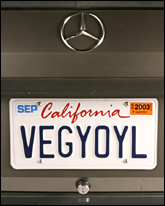Dear Umbra,
A few years ago, I bought a Prius because it was (and still is, unfortunately) the best car that’s offered in our messed-up world. I’m now going to buy an old diesel Mercedes and convert it to run on used vegetable oil. I think this might be the best way to go. What are your thoughts on this? Thanks!
Jilli
Tarzana, Calif.
Dearest Jilli,
I answered the main part of your question in my last column, and in so doing, I promised readers that a fuller exploration would be forthcoming — so if you don’t mind, I’m going to use this opportunity to explain how straight vegetable oil (SVO) conversion works. En suite, peoples, the next class in Umbra’s Basic Diesel School.
In a diesel engine, the fuel leaves the tank via tubes, enters the fuel injector, and is forcefully sprayed into the engine, where it combusts. Diesel engines were designed with fuel oils of all types in mind, including vegetable oil. You could buy a bottle of Crisco and pour it into the tank and the car would run — but not well, and not for long. Vegetable oil is naturally more viscous than petro diesel or biodiesel, so getting it to the point where it is liquid enough to pass through the tubes to the combustion chamber requires a significant amount of heat and can be quite difficult if the engine is cold. Additionally, SVO will gum up the works if it reaches the engine but then is left to cool. Moreover, SVO that isn’t hot enough burns incompletely, and thus inefficiently.
Converting an engine to run on SVO, then, means tinkering with the fuel-delivery system to warm the SVO before it passes through the tubes and, in some cases, heating it again before it enters the combustion phase. For the mechanically minded this is a thrilling challenge, and if you want to design your own conversion system, go for it. The rest of us will have to rely on commercially available systems.
These systems almost all entail installing what is basically a second fuel system: separate SVO tanks and hoses, a heating system in said tank and/or on the way to the engine, a device for routing radiator heat to said systems, and a way to switch between diesel and SVO. With these systems, the car initially starts using diesel (or biodiesel) from the original fuel tank. When the engine and the SVO have both been heated for a sufficient amount of time, the driver flips a switch and the fuel delivery system changes over to the SVO tank. At the end of the drive, the driver must reverse the process so that when the engine comes to a stop there is diesel in the tank and the fuel lines, rather than soon-to-be-gooey SVO.
SVO conversion kits are readily available and range from about $650 to $1,500 without installation. They can be found at Frybrid, Greasel, Greasecar, Neoteric, and Elsbett. (The Frybrid folks live in my area, although not quite in my basement, and I spent some time visiting with them a few weeks back. Fun.) The world of SVO conversion is filled with lively debate over which system is best, so before you proceed with your dream, spend a chunk of time on these and other websites developing your own opinion. Running biodiesel can be a passive act of consumption at this point in certain areas of the country, but the SVO-conversion technology is new enough that you need to be informed before you make the leap. You also need to have a good mechanic and the willingness to be actively involved with your car. That’s my advice.
My other advice is to spend time learning what it takes to obtain and process used restaurant oil. My Frybrid friend takes all the oil produced by a nearby Japanese restaurant, heats it for six hours in an old water heater, removes the resultant water, and then filters the oil until no particles remain that are larger than five microns. He’s a particular kind of fellow, and some will insist that you don’t need to go that far, but again, this is something you should decide for yourself.
I hope you go ahead with your plan; good luck.
Viscously,
Umbra


